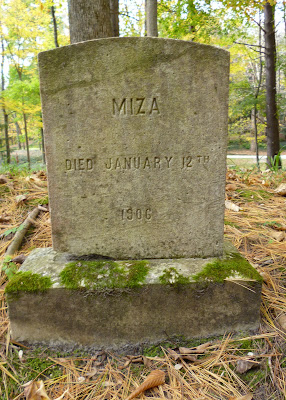Edith Wharton was forty years old when she moved into The Mount, in Lenox in the Berkshires in 1902, considering this to be her 'first real home'. The co-author, with architect Ogden Codman Jr, of The Decoration of Houses (1898), Wharton had very firm ideas about architecture, and she worked with Ogden and L. V. Hoppin on The Mount, it has to be said she was the real designer of the house.
Both the book and the house firmly reject Victorian excesses and proclaim a return to Classical simplicity and symmetry.
Edith had married Teddy Wharton, a man twelve years her senior and from a prominent Boston family, in 1885. As the note bottom right states: 'Teddy Wharton in 1898 with Jules, Miza and Mimi. The University of California, Berkeley.'
The drive leading up to the house has an impressive stable block.

The gallery on the second (or first in British English) floor, which is of Italian inspiration, and contained objects from Wharton's travels.
The dining room with Victorian table and French armchairs.
The plasterwork is designed by Ogden Codman and inspired by Grinling Gibbons.
The dining room, with elaborate ceiling, was recreated in this, the largest room in the house. Two tapestries from Brussels ('Narcissus at the Fountain' and 'Bacchus and Ariadne') dating from about 1710, have been reproduced here.
The library.
'She would have her writing board perilously furnished with an ink-pot on her knee, the dog of the moment under her left elbow and the bed strewn with correspondence, newspapers and books.'
Teddy Wharton's den, where he would relax.
Bath and toilet.
And Edith Wharton herself with two of her dogs.
The lift.
The terrace at the rear of the house.
And the rear of the house itself.
The pet cemetery contains a number of dogs' graves.
Such as Miza's.
And Mimi's.
Along with an inscription in French to one:
'A
PETIT PIERROT
NOTRE AMI CHER
1922'
The Whartons' stay at The Mount was relatively short: the marriage was disintegrating along with Teddy's mental health, and Edith moved to France. The third floor (or second in English) of the house now is mainly dedicated to displays, such as the large room giving details of Wharton's activities in World War I, during which she gave much attention to charities, and her writing was a chronicle of the war. By 1914 she was divorced, rich and famous, and would spend the rest of her life in France. Returning from a three-week trip to Spain with Walter Berry, the President of the Chamber of Commece in America, they discovered that a number of countries were gearing up for war. It was Berry who prevented Wharton's car from being requisitioned in the effort to curtail civilian travel.
Wharton's movements were restricted to the Parisian area, but a map on the third floor lists Wharton's many charitable interests in and around Paris.
As an example of her activities, she encouraged writers and illustrators to submit work for her edition of The Book of the Homeless (Le livre des sans-foyers), which contained an Intoduction by Theodore Roosevelt (to whom she was related by marriage) urging people to support Belgian children who had fled Belgium.
It was difficult to get a pass to the front, although Wharton went several times, resulting in works of both fiction and non-fiction: Fighting France, The Marne, French Ways and Their Meaning, A Son at the Front. It is perhaps needless to say that she was caricatured, as it this copy of Le Rire, where she is prepresented going off to the front with Walter Berry.
When the war ended, Wharton cheered the troops as they marched through Paris. She moved twenty miles north of Paris – Saint-Brice-sous-Forêt – in 1919, and spent the winter months at Sainte-Claire-du-Chateau near Hyères. Her Age of Innocence won her the Pulitzer Prize in 1920, and she died at the age of 75 in 1937.
Her apartment was at 53 rue de Varenne, near the Jardin du Luxembourg, and this is a photo of the building and the plaque on it that I took in Paris last month.
'Dans cet immeuble vécut de 1910 à 1920
EDITH WHARTON
Romancière américaine
1862 — 1937
Elle fut le premier écrivain des Etats—Unis à s'expatrier en France,
par amour de ce pays et de sa littérature.'
['In this house from 1910 to 1920 lived
EDITH WHARTON
American Novelist
1862 — 1937
She was the first writer from the United States to repatriate in France,
She was the first writer from the United States to repatriate in France,
out of love for this country and its literature.']
'My years of Paris life were spent entirely in the rue de Varenne
— rich years, crowded and happy years.'
'Les années de ma vie parisienne, je les ai passées entiérement rue de
Varenne—années fructueuses, bien remplies, des années heureuses.'
'Proche de Henry James, l'oeuvre d'Edith Wharton met en scène, d'un trait
à la fois délicat et mordant, la bonne sociéte dont elle est issue.'
['Like Henry James's, Edith Wharton's work, subtle and incisive at the same time, theatricalizes the high society from which she came.']
'Association la Mémoire des Lieux'
The Whartons sold The Mount September 1911 to Albert R. Shattuck (a banker in New York and New Orleans) and his wife Mary Strong, There is no evidence of their additions to the property, and they died there in 1925 and 1935.
The Van Andas subsequently bought it as a summer home, and the property was sold again in the 1940s. Foxhollow School for Girls owned the property from 1942 to 1976, and in 1978 The Mount became the home of Shakespeare and Company (S&C), which, led by Tina Packer, originally wanted to buy the property and created the Edith Wharton Corporation (EWC), although the two organizations became wholly separate, and in 1980 the EWC took possession of the property. S&C moved elsewhere in Lenox in 2001.























































